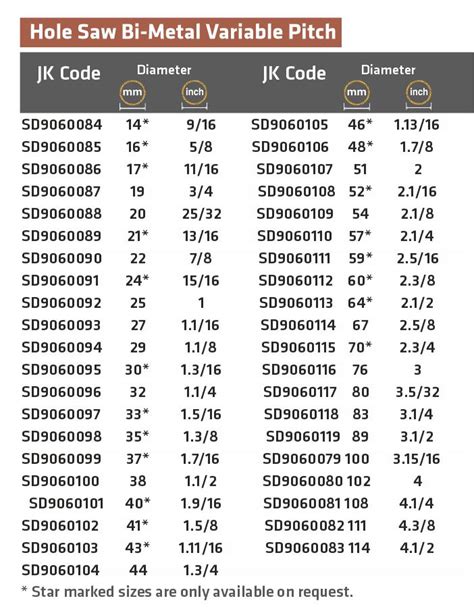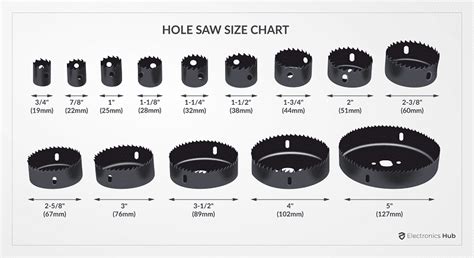electrical box metal hole saw trade sizes While you might think you need to size a pilot bit the same way you size any drill bit, it’s not quite the same thing. Using the proper pilot bit is essential for aligning the hole and supporting . See more What is a truss? A truss in everyday language is a rigid structure that is made up of a collection of straight members. But in an engineering and strength of materials context it has a more specific meaning – in these contexts a truss is a structure made up of members that only carry axial loads.
0 · pipe hole saw size chart
1 · hole saw sizes
2 · electrical conduit hole sizes
3 · conduit hole saw size chart
The Gladiator Premier Jumbo Cabinet is a beast. 3 feet wide. 2 feet deep. 6 feet tall. 21 gauge steel. This cabinet is going to accommodate all your storage needs. This cab has 3 shelves.
pipe hole saw size chart
First, let’s quickly identify the kind of project you need to work on. Some Common Projects where I’ve used hole saws include the following. See moreI find it easier to check the hole saw recommendation chart below for the type of hole saw I’d use: Now: All you have to do is cross-reference your application to the hole saw type. . See moreNext, refer to the chart for plumbing to see what hole saw sizes are available. Basically, you want to make sure it matches the size of your pipe. Use the following chart for . See more
Let me walk you through a recent project I had for my bathroom pipes (metal). I deemed Bosch bi-metalhole saws perfect for metal pipes and wood materials. To slip my 2 ½-inch pipe . See more
While you might think you need to size a pilot bit the same way you size any drill bit, it’s not quite the same thing. Using the proper pilot bit is essential for aligning the hole and supporting . See more
Electrical conduit hole saw sizes are not the exact dimensions as the trade name size of the conduit. Table of Contents: Drilling With A Hole Saw; Hole Saw Sizes and Knockout Punch .Electrician’s Conduit Hole Saw Sizes Guide 1/2″ Trade Size conduit, drill using a 7/8″ hole saw or 1/2″ conduit knockout punch (.885″ or 22.5mm). 3/4″ Trade Size conduit, drill using a 1 1/8″ . Here are typical hole saw sizes you'll come across, recommended RPM to cut different material, and common uses.
Electricians commonly use hole saws in sizes ranging from 1/2 inch to 6 inches, depending on the specific job requirements. This allows them to cut holes of various diameters .
The accuracy of a knockout tool is vital because an imprecise hole will prevent the conduit from aligning properly. This is why the knockout size is so important. If you look at the openings on the side of your electrical boxes, you will notice . There are some standardized sizes for hole saws, particularly for the smaller diameters commonly used in electrical or plumbing work. These sizes are often referred to as "trade sizes" and are based on the nominal diameter .
Learn about Hole Saws, Different Types of Hole Saws (Bimetal, Carbide). Hole Saw Size Chart helps you with pipe sizes, Pipe Entrance, RPM.Use a handy hole saw size chart and our guide to choose proper hole saw sizes for your electrical, plumbing, woodworking projects and more.Electrical conduit hole saw sizes are not the exact dimensions as the trade name size of the conduit. Table of Contents: Drilling With A Hole Saw; Hole Saw Sizes and Knockout Punch Equivalent; Hole Sizes for Tapping Conduit Threads; Knockout Punch Operating Instructions; Greenlee Knockout Punch Replacement Part Numbers; DRILLING WITH A HOLE SAWElectrician’s Conduit Hole Saw Sizes Guide 1/2″ Trade Size conduit, drill using a 7/8″ hole saw or 1/2″ conduit knockout punch (.885″ or 22.5mm). 3/4″ Trade Size conduit, drill using a 1 1/8″ hole saw or 3/4″ conduit knockout punch (1.115″ or 28.3mm).
Here are typical hole saw sizes you'll come across, recommended RPM to cut different material, and common uses. Electricians commonly use hole saws in sizes ranging from 1/2 inch to 6 inches, depending on the specific job requirements. This allows them to cut holes of various diameters in materials such as wood, plastic, and metal, making it easier to .

hole saw sizes
The accuracy of a knockout tool is vital because an imprecise hole will prevent the conduit from aligning properly. This is why the knockout size is so important. If you look at the openings on the side of your electrical boxes, you will notice that they are a perfect fit for electrical conduits. There are some standardized sizes for hole saws, particularly for the smaller diameters commonly used in electrical or plumbing work. These sizes are often referred to as "trade sizes" and are based on the nominal diameter of the hole saw. Learn about Hole Saws, Different Types of Hole Saws (Bimetal, Carbide). Hole Saw Size Chart helps you with pipe sizes, Pipe Entrance, RPM. For 1/2 pipe I would use a 7/8" hole saw. For 3/4" I would use 1 1/8" saw. For each pipe size I add 3/8" to the size of the pipe. I also have various size self feeder bits for different pipe sizes but just the ones I normally use. I like to add a spare conduit from an .
A lot of the time and the size of the hole you want to makes is determined by the drill bit you use. So, here’s a handy chart that shows you just what drill bit sizes you can use with which hole saws. Here we mark on the table which size hole saw perfect for 2 inch EMT.
Use a handy hole saw size chart and our guide to choose proper hole saw sizes for your electrical, plumbing, woodworking projects and more.Electrical conduit hole saw sizes are not the exact dimensions as the trade name size of the conduit. Table of Contents: Drilling With A Hole Saw; Hole Saw Sizes and Knockout Punch Equivalent; Hole Sizes for Tapping Conduit Threads; Knockout Punch Operating Instructions; Greenlee Knockout Punch Replacement Part Numbers; DRILLING WITH A HOLE SAWElectrician’s Conduit Hole Saw Sizes Guide 1/2″ Trade Size conduit, drill using a 7/8″ hole saw or 1/2″ conduit knockout punch (.885″ or 22.5mm). 3/4″ Trade Size conduit, drill using a 1 1/8″ hole saw or 3/4″ conduit knockout punch (1.115″ or 28.3mm). Here are typical hole saw sizes you'll come across, recommended RPM to cut different material, and common uses.
Electricians commonly use hole saws in sizes ranging from 1/2 inch to 6 inches, depending on the specific job requirements. This allows them to cut holes of various diameters in materials such as wood, plastic, and metal, making it easier to .The accuracy of a knockout tool is vital because an imprecise hole will prevent the conduit from aligning properly. This is why the knockout size is so important. If you look at the openings on the side of your electrical boxes, you will notice that they are a perfect fit for electrical conduits.
There are some standardized sizes for hole saws, particularly for the smaller diameters commonly used in electrical or plumbing work. These sizes are often referred to as "trade sizes" and are based on the nominal diameter of the hole saw. Learn about Hole Saws, Different Types of Hole Saws (Bimetal, Carbide). Hole Saw Size Chart helps you with pipe sizes, Pipe Entrance, RPM. For 1/2 pipe I would use a 7/8" hole saw. For 3/4" I would use 1 1/8" saw. For each pipe size I add 3/8" to the size of the pipe. I also have various size self feeder bits for different pipe sizes but just the ones I normally use. I like to add a spare conduit from an .

Sheet metal thickness is vital for vehicle durability. The standard measurement for this thickness is “gauge,” with a higher gauge number indicating a thinner piece of metal. The gauge system is often used in conjunction with .
electrical box metal hole saw trade sizes|hole saw sizes